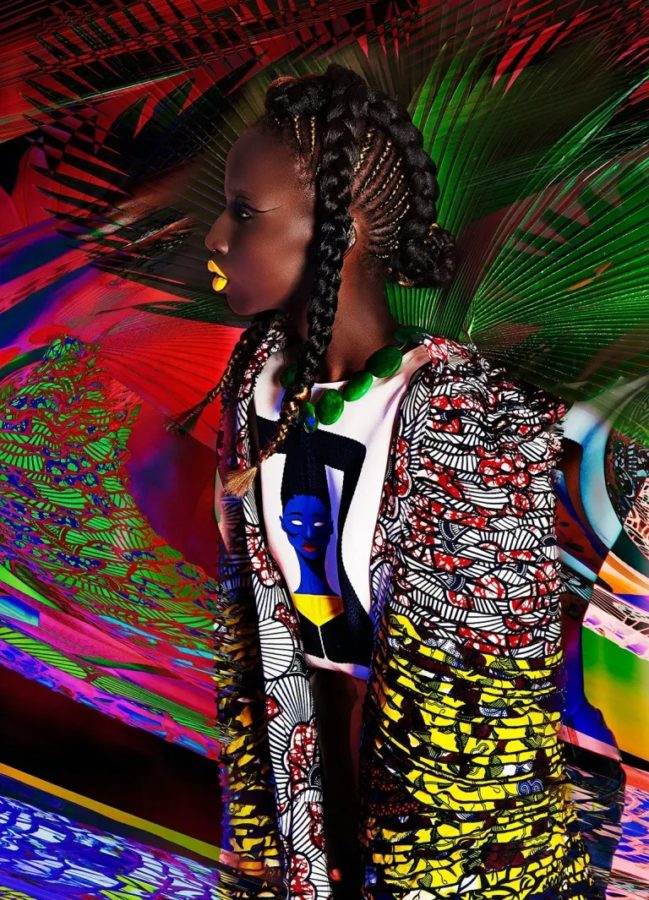CMA’s “The New Black Vanguard” envisions the future of fashion photography
“The New Black Vanguard: Photography Between Art and Fashion” at the CMA displayed the work of budding Black artists like Namsa Leuba, whose work is pictured here.
September 16, 2022
Modern artists do more than just capture a moment. They ride the line between the present and the future, creating works that are infused with emotional revelation as well as visual appeal. This balance is extremely visible in the Cleveland Museum of Art’s “The New Black Vanguard: Photography Between Art and Fashion,” an exhibition of works by contemporary artists who utilize passion and vision to embody their personal reactions to living in the here and now.
“The New Black Vanguard” includes photographs captured by 15 different “image-makers,” all of whom were born in the late ‘80s or early ‘90s. Hung against walls swathed in lush reds and purples, illuminated by pulses of strobed lighting, the works illustrate a silent, but not indecipherable, narrative that carries the viewer through a journey of human intimacy, and invites spectators to feel as deeply as they observe.
In the long history of human art, photography represents the cutting edge of creative progression, with its technological advancements making it one of the most influential driving factors in the modern artistic revolution. The artists whose works comprise “The New Black Vanguard” use this to their advantage, combining their youth with the relative novelty of photography to lend a palpable gravity to their images. The desperate hunger to establish individual self-expression seeps out of the frames, but only after it has swept the subjects up in the glow of assured vulnerability.
As photographers of color capturing fashion, the artists of “The New Black Vanguard” blur the lines between art and commodification. Each picture recreates a story—a single instance within an infinitely larger life—but at the same time we are reminded that every frame is a part of the grander-still complex tapestry that is contemporary media. One particular line in the exhibit’s introduction muses on this reality, stating that “[these] photographs open conversations around the representation of the Black body and Black lives as subject matter; collectively, they celebrate Black creativity and the cross-pollination between art, fashion, and culture in constructing an image.” “The New Black Vanguard” creates a space that minimizes the noises of the social world, allowing the viewer to focus on the artists’ ideas rather than the all-consuming nature of the digital 21st century. The exhibition presents viewers with art that is made by and for the greater social collective. In their daily lives, human beings exude as much, if not more, aesthetic and aspirational value as expensive portraits sketched by the Old Masters or a jewel-toned pump painted by Warhol do.
Through “The New Black Vanguard,” the viewer witnesses the unfolding of stories about identity and history, love and fantasy, race and existence—all presented in confident, unyielding depictions. Bright flashes of yellow command attention in photographs of Lagos street fashion by Stephen Tayo, sparkles spill out of Quil Lemons’ “Glitterboy” series on sexual expression, and popping fabrics clash against deserts and mountains in Nadine Ijewere’s landscapes, evoking images of Hollywood glamour and haute couture. “The New Black Vanguard” is as much a presentation of the visual charms of fashion as it is a reflection on how the artists and their models are navigating today’s world. These are pensive, self-perceiving images, ones that are critical as well as forgiving, fully illustrative of the daily push-and-pull that gives strength to our own personalities and stories.
Instead of selling a dream as conventional fashion photography does, “The New Black Vanguard” gives us a series of highly personal moments, pulling back the curtain on the unadulterated beauty of existence and granting us access into lives that run parallel to our own. It is a collection of ruminations as much as it is a gathering of moments, a chance to linger on all of the snapshots of a life.
“The New Black Vanguard: Photography Between Art and Fashion” ran from May 5 through Sept. 11 at the Cleveland Museum of Art and was curated by New York City-based art critic and writer, Antwaun Sargent.


